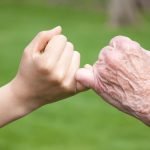Geriatric Health: Elder Abuse, Neglect, Ageism, & Social Isolation
Docere
Thomas A. Kruzel, ND
Elder abuse, neglect, loneliness, and the difficulties encountered with ageist attitudes are some of the biggest challenges faced by the elderly in most societies worldwide. The World Health Organization (WHO), in its World Report on Health and Aging (2015), addresses many of the issues facing individuals as well as governments in dealing with an ever-increasingly aging population.
The number of individuals in the United States over the age of 65 tripled during the 20th century, and this number is expected to more than double within the next 25 years.1 As a consequence, elderly Americans, who in 1900 comprised only 1 in 25 (3.1 million), made up 1 in 8 (33.2 million) in 1994. According to the Census Bureau’s projections, the number of elderly Americans is expected to more than double by the year 2050 – to 80 million – with most of this growth occurring between 2010 and 2030.1 This means that during this period, the number of elderly will increase annually by roughly 2.8%, with the ethnic diversity of the aging population remaining similar to what it currently is.1
The most rapidly growing older age group, ie, the “oldest old,” is comprised of those aged 85 and over.1 Their numbers increased by 274% between 1960 and 1994. While the US population, as a whole, grew only 45%, the elderly population rose 100%.1 In 1994 the 3-million oldest old constituted 10% of the elderly and just over 1% of the entire population. Due to the arrival of baby boomers, the oldest old is expected to number 19 million by the year 2050.1 That will make them 24% of elderly Americans and 5% of all Americans.
Adding to this increase, during this period, total mortality rates have decreased approximately 19%, with women, overall, outliving men of all nationalities and ethnicities.2
The present medical system is ill-prepared to treat the ever-increasing elderly population, due in part to both the compartmentalization of care that allopathic medicine has become and a lack of understanding of the aging process. Additionally, physicians generally treat older patients differently, as they are less comprehensive and aggressive when faced with the complexity of an elderly person’s many comorbid diseases.2 With the exception of geriatricians, a few family practice physicians, and naturopathic physicians, most physicians have not received the necessary training to treat an increasingly complex and aging population.
Additionally, the present allopathic system actually contributes to increased elder morbidity through the use of polypharmacy. The elderly constitute roughly 12% of the US population, yet, according to a 2006 report,3 they consume approximately 34% of all prescription drugs and 40% of over-the-counter drugs.
What compounds this problem is that all patients, but elderly patients in particular, become caught up in an endless cycle of doctor visits to address drug-induced problems. What is problematic for the elderly is that they are often overlooked and that their medical complaints, especially those that are medication-induced, are often dismissed as simply being part of the aging process. Ageism takes many forms within society, and the medical community is certainly not immune from it.
Social Isolation
Social isolation has been defined as “a state in which the individual lacks a sense of belonging socially, lacks engagement with others, has a minimal number of social contacts and is deficient in fulfilling and quality relationship.”4 Though rates of social isolation among community-dwelling older adults are not widely available, it is estimated that up to 20% of older adults experience social isolation to some degree5; however, depending on the study, ranges of 10% to 43% have been reported.4,5
Risk factors for development of social isolation include living alone, having multiple chronic health problems, having no children or family to connect with, lack of access to transportation, low income level, critical life changes such as retirement, changes in family structure such as a change in residence or loss of a spouse or family member, and being 80 years of age or older.6
Social isolation has been found to be a significant predictor of mortality, as shown by a number of studies. It is as strong a predictor of early death as smoking, excessive alcohol consumption, or unhealthy diets.6 Isolated older adults are more likely to experience falls, coronary artery disease, stroke, depression, and suicide.6 Social isolation has been shown to be a significant risk factor for hospitalization and hospital readmission among older adults.7,8 Older adults who are socially isolated are 4 to 5 times more likely, in general, to be hospitalized compared to older adults.6
There has also been a correlation made between being socially isolated and the development of dementia and cognitive decline.6 Along these lines it has been shown that conversely, social inclusion significantly protects against dementia and death.9,10
Loneliness
A lonely person is generally defined as a person “affected with, characterized by, or causing a depressing feeling of being alone, or lonesome… a person who is destitute of sympathetic or friendly companionship, intercourse, or support… an individual who lives in solitary, without company and companionship.”11
Loneliness is highly subjective and is often measured using questionnaires that seek individuals’ perceptions of, and feelings about, their relationships and social activity. Answers to these will vary for a variety of reasons, such as individual perceptions, upbringing, and peer and ethnic group associations to name a few.
Because of this, loneliness is a perception that cannot be objectively observed. Victor et al (2000)12 view it as: “perceived deprivation of social contact, the lack of people available or willing to share social and emotional experiences, a state where an individual has the potential to interact with others but is not doing so, and a discrepancy between the actual and desired interaction with others.”12 Within these definitions of loneliness are external loneliness, which is brought about by a person’s life circumstances (such as loss of a spouse), and internal loneliness, which relates more to personality type of the individual. The terms loneliness and social isolation are often used interchangeably or integrated into a definition that endeavors to encompass both of them.
Depending upon the literature consulted, there is somewhat of a debate as to whether impaired health promotes isolation and loneliness, or being lonely and isolated leads to impaired health.13 Regardless, poor health does appear to play a role as a risk factor for the development of both isolation and loneliness.13 This can occur because of having a reduced capacity to participate in social activities, or a loss of independence and ability to communicate with others. Elders with disabilities find additional barriers to interacting socially, which compounds the problem.
A number of intervention strategies have been proposed to counter isolation and loneliness among the elderly, such as group activities for bereavement support, becoming more socially active, volunteerism, discussion groups and involvement in community activities. These have met with varying degrees of success but are not universally embraced.14,15
It is important as primary care physicians to ask our elderly patients about their normal activities of daily living (ADLs), social activities, and whether they are experiencing loneliness. This is especially important if they are experiencing depression or have just gone through a significant life change of some sort. Oftentimes, they will not volunteer the information because their previous physicians have not asked, or could not or would not address their concerns when asked. Therefore, it is something that should be addressed at each visit.
Ageism & Physician Attitudes
Ageism tends to be multi-faceted, manifesting itself in a variety of ways. These take the form of prejudicial attitudes about the aging process, discrimination against the elderly, and social and institutional practices that reinforce stereotypes about the elderly.6 Ageism can influence the way clinical decisions are made, resulting in age-related biases and a substandard level of care.
Age bias in medicine takes a variety of forms. Healthcare professionals, as a rule, do not receive enough training in geriatrics to properly care for many older patients. This is especially seen with specialist care, the group that delivers the most medical care to this cohort.
Older patients, a group identified as needing more preventive care, are less likely than younger people to receive it. They’re also less inclined to be screened for diseases and other health problems. Because proven medical interventions for elderly patients are often ignored, these patients often receive inappropriate or incomplete treatment. Moreover, older patients are frequently excluded from clinical trials, despite being the largest users of approved medications.16
Elder Abuse & Neglect
The WHO defines the abuse of older adults as “a single or repeated act, or lack of appropriate action, occurring in any relationship where there is an expectation of trust that causes harm or distress to an older person.”17 Elder abuse can devastate an older individual’s quality of life, and significantly increase his or her overall risk of mortality. Elder abuse can take several forms, including physical abuse, emotional or psychological abuse, sexual abuse, financial abuse, and general neglect.6
Most of the care that seniors receive in their later years is provided by a family member, who more often than not, is not adequately prepared to render the care that may be needed. This becomes especially difficult if the elder is depressed, has some dementia, or delirium is present.
The group of elders most often affected are women over 75 years of age who are widowed and generally of lower income.18 The tendency for abuse and neglect increases the older one becomes, and is compounded by social isolation, a condition that is becoming increasingly more common.
Abuse tends to be chronic in nature,19 with periods when it is increased and periods when it is less. There are no racial or socioeconomic distributions, and the elderly are often afraid to report or testify against an abuser for fear of retribution, or because the abuser is a member of their family.
A family member most often perpetrates abuse of the elder. However, nonfamily or institutional caregivers can be found as well. Often the child who is the least socially-integrated sibling ends up being the caregiver, or is in the position by default because other family members will not or are unable to take responsibility. Often there is an increased amount of depression found in caregivers, as well as increases in alcohol abuse and drug use. If violent behavior is found, it is most often a learned behavior, as many of the abusers were victims themselves, often at the hands of the elder they must care for.
Physicians must be aware of the signs and symptoms of abuse, such as bruises, welts, rope or restraint burns, or marks on ankles and wrists. Pallor, dehydration, and weight loss, multiple fractures, or subdural bleeding are flags for ongoing abuse and neglect.20 If the elder exhibits behavioral signs such as fear and anxiety, being withdrawn and non-communicative, or exhibiting hostility toward caregiver or physician, also suspect abuse.20
If the caregiver presents with excessive concerns about the elderly patient, or is constantly harping on the burdens of caregiving, suspicion should be raised that there may be abuse or neglect. If the caregiver’s explanations of symptoms of the elderly person do not seem reasonable or fit the clinical presentation, this is also a reason to suspect abuse or neglect.
Acute changes in behavioral patterns of the elderly patient not only can signify an occult infectious or metabolic disease, but also a pattern of abuse. It has also been my experience that if the elderly patient presents with unusual conditions such as encopresis or random or unexplained urinary incontinence, abuse or neglect must be considered.
Recommendations
When making assessments of an elderly patient who is now in transition to needing home or assisted care, consider evaluating the caregiver as well. What will the transition of the person becoming the caregiver involve? Is it a sudden transition, or has it been present for a while? Was this an expected or unexpected transition? How does it affect their life as well as the person being cared for? Is this a positive or negative experience for them?
What are the characteristics of the caregiver? What is their health status, their ego strength? Do they have any prior experience caring for others? How socially integrated are they? What is their education level? And do they also have a support network?
As primary care naturopathic physicians, it is imperative that we treat the whole person, which also includes their family and caregiver. Therefore, recognition and intervention for social isolation, abuse, and neglect early on is the best strategy for prevention.
Take time to talk with the caregiver and elder at each visit, making sure that either you or someone else follows up if problem areas are identified. A counseling referral and frequent follow-up visits will often put the caregiver and elder at ease.
Recognize the needs of the caregiver, and help develop care and coping strategies with them. Provide options such as senior or state social services, or help with respite care for the care provider.
If abuse is uncovered, report all abuses to Elder Protective Services or other social agencies. Be prepared to testify if needed, and be able to back up your claims with medical evidence from your examination. Referral to other physicians or to an emergency room for documentation may be necessary in order to establish abuse.
Recognizing and addressing elder abuse, neglect, and loneliness early on will help to provide a better quality of life in one’s later years.
 Thomas A. Kruzel, ND, graduated from NCNM and is in private practice at the Rockwood Natural Medicine Clinic in Scottsdale, AZ. He completed 2 years of family practice medicine residency at the Portland Naturopathic Clinic, where he was Chief Resident prior to entering private practice, and completed a fellowship in geriatric medicine through the OR Geriatric Education Center and the Portland VA hospital. Dr Kruzel is the author of the Homeopathic Emergency Guide: A Quick Reference Handbook to Effective Homeopathic Care and the Natural Medicine Pediatric Home Health Advisor; he has also published numerous articles. Dr Kruzel was past-president of the AANP, and was selected as Physician of the Year by the AANP in 2000, and Physician of the Year by the AZ Naturopathic Medical Association in 2003.
Thomas A. Kruzel, ND, graduated from NCNM and is in private practice at the Rockwood Natural Medicine Clinic in Scottsdale, AZ. He completed 2 years of family practice medicine residency at the Portland Naturopathic Clinic, where he was Chief Resident prior to entering private practice, and completed a fellowship in geriatric medicine through the OR Geriatric Education Center and the Portland VA hospital. Dr Kruzel is the author of the Homeopathic Emergency Guide: A Quick Reference Handbook to Effective Homeopathic Care and the Natural Medicine Pediatric Home Health Advisor; he has also published numerous articles. Dr Kruzel was past-president of the AANP, and was selected as Physician of the Year by the AANP in 2000, and Physician of the Year by the AZ Naturopathic Medical Association in 2003.
References:
- US Census Bureau. Sixty-Five Plus in the United States. Economics and Statistics Administration, U.S. Department of Commerce. May 1995. US Census Bureau Web site. https://www.census.gov/population/socdemo/statbriefs/agebrief.html. Accessed June 15, 2016.
- Hazzard WR, Blass J, Ettinger W, et al, eds. Principles of Geriatric Medicine and Gerontology. 4th ed. New York, NY: McGraw-Hill; 1999.
- Pervin L. Polypharmacy and Aging: Is There Cause for Concern? ARN Network. Gerontology Update. February/March 2008. Available at: http://www.rehabnurse.org/pdf/GeriatricsPolypharmacy.pdf. Accessed June 15, 2016.
- Nicholson NR Jr. Social isolation in older adults: an evolutionary concept analysis. J Adv Nurs. 2008;65(6):1342-1352.
- Smith TF, Hirdes JP. Predicting social isolation among geriatric psychiatry patients. Int Psychogeriatr. 2009;21(1):50-59.
- Addressing Ageism, Elder Abuse, and Social Isolation: Make Addressing Ageism, Elder Abuse and Social Isolation a National Priority. National Seniors Strategy Web site. http://www.nationalseniorsstrategy.ca/the-four-pillars/pillar-1/addressing-ageism-elder-abuse-and-social-isolation/. Accessed June 15, 2016.
- Greysen SR, Horwitz LI, Covinsky KE, et al. Does social isolation predict hospitalization and mortality among HIV+ and uninfected older veterans? J Am Geriatr Soc. 2013;61(9):1456-1463.
- Mistry R, Rosansky J, McGuire J, et al. Social isolation predicts re-hospitalization in a group of American veterans enrolled in the UPBEAT program. Int J Geriatr Psychiatry. 2001;16(10):950-959.
- Fratiglioni L, Wang HX, Ericsson K, et al. Influence of social network on occurrence of dementia: a community-based longitudinal study. Lancet. 2000;355(9212):1315-1319.
- Giles LC, Glonek GF, Luszcz MA, Andrews GR. Effect of social networks on 10 year survival in very old Australians: the Australian longitudinal study of aging. J Epidemiol Community Health. 2005;59(7):574-579.
- com. Lonely. Available at: http://www.dictionary.com/browse/loneliness. Accessed June 15, 2016.
- Victor C, Scambler S, Bond J, Bowling A. Being alone in later life: loneliness, social isolation and living alone. Rev Clin Gerontol. 2000;10(4):407-417.
- Social Isolation Among Seniors: An Emerging Issue. March 2004. Children’s, Women’s and Seniors Health Branch, British Columbia Ministry of Health. Available at: http://www.health.gov.bc.ca/library/publications/year/2004/Social_Isolation_Among_Seniors.pdf. Accessed June 15, 2016.
- Cattan M, White M. Developing evidence based health promotion for older people: a systematic review and survey of health promotion interventions targeting social isolation and loneliness among older people. December 29, 1998. Internet Journal of Health Promotion. 1998. Available at: http://www.iuhpe.org/rhpeo/ijhp-articles/1998/13/index.htm. Accessed June 15, 2016.
- Cattan M, White M, Bond J, Learmouth A. Preventing social isolation and loneliness among older people: a systematic review of health promotion interventions. Ageing Soc. 2005;25:41-67. Available at: http://www.ncbi.nlm.nih.gov/pubmedhealth/PMH0022350/. Accessed June 15, 2016.
- Alliance for Aging Research. Ageism: How Health Care Fails the Elderly. Available at: http://tinyurl.com/jewkfc3. Accessed June 15, 2016.
- World Health Organization. A Global Response to Elder Abuse and Neglect: Building Primary Health Care Capacity to Deal with the Problem Worldwide: Main Report. August 2008. WHO Web site. http://www.who.int/ageing/publications/ELDER_DocAugust08.pdf. Accessed June 15, 2016.
- WHO/INPEA.(2002). Missing voices: Views of older persons on elder abuse. Available at: http://apps.who.int/iris/bitstream/10665/67371/1/WHO_NMH_VIP_02.1.pdf. Accessed June 15, 2016.
- World Health Organization. Chapter 5: Abuse of the Elderly. In: World report on violence and health. 2016. Available at: http://www.who.int/violence_injury_prevention/violence/global_campaign/en/chap5.pdf. Accessed June 15, 2016.
- National Center on Elder Abuse. Types of Abuse. NCEA Web site. http://www.ncea.aoa.gov/FAQ/Type_Abuse/index.aspx. Accessed June 15, 2016.










